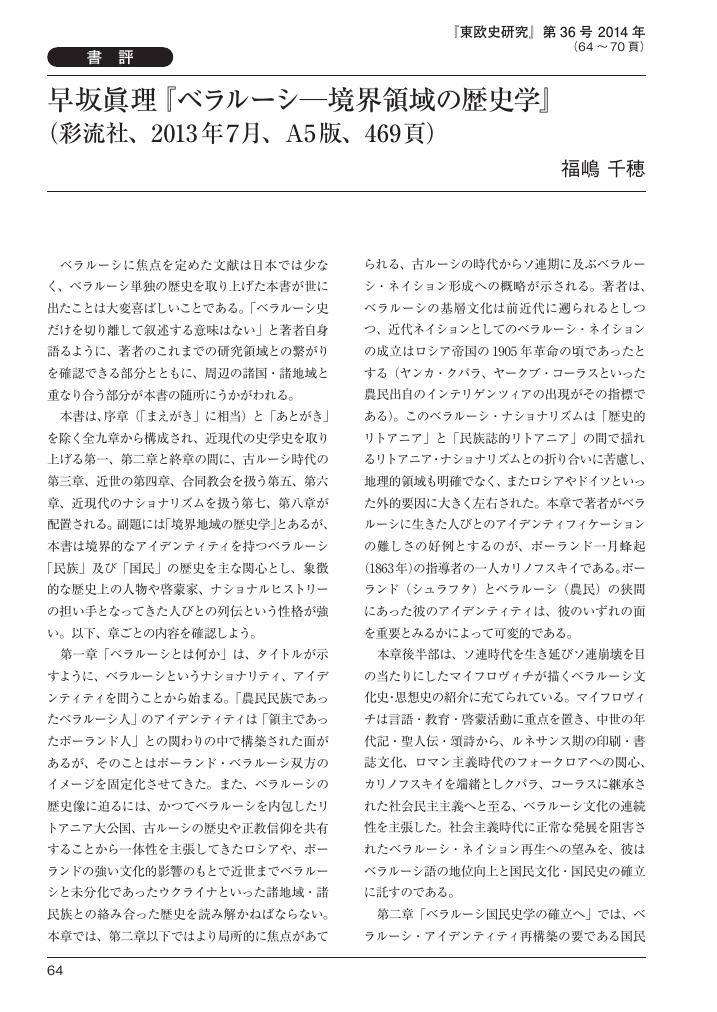2 0 0 0 IR 近世ポーランド・リトアニア共和国におけるルテニア--教会合同問題にみる諸階層
- 著者
- 福嶋 千穂
- 出版者
- 北海道大学スラブ研究センター
- 雑誌
- スラヴ研究 (ISSN:05626579)
- 巻号頁・発行日
- no.58, pp.197-227[含 英語文要旨], 2011
The early modern composite-monarchy Polish-Lithuanian Commonwealth possessed Ruthenian lands on its Eastern borderlands. Ruthenia had its historical roots in Kievan Rus, and kept the Orthodox faith within the Catholic-dominant Commonwealth. Orthodoxy (Kievan Metropolitanate) represented Ruthenia's peculiar regionalism, while Ruthenia had never been given any administrative entity in the Commonwealth. Orthodoxy, which had been tightly connected with Ruthenian regional and ethnic identity, began to be challenged when the Orthodox higher clergy in Ruthenia declared church union with the Catholic Church (Union of Brest, 1596). The majority of the hierarchy accepted Catholic dogma and the Pope's supremacy on condition that Eastern rites and customs be sustained, while the majority of secular nobles resisted this union. After church union, the Ruthenian Church divided into two: the Uniates and the Disuniates (Orthodox). This church union in Ruthenia and its significance have been studied mainly from three perspectives: church history (both Catholic and Orthodox), Ukrainian national history (Eastern-oriented and Western-oriented), and social structure. In this article, I examine a variety of questions arising from the Union of Brest in Ruthenia, by comparing the ways in which those belonging to different social strata attempted to answer them to satisfy their own interests. The Ruthenian nobility, the sole local group with political rights as a political nation of the Commonwealth, considered that all such confessional issues had to be solved by legal processes, that is, parliamentary activities. Since the majority of the secular Ruthenian nobility was against church union, which might threaten their privilege of freedom of faith, they supported the Orthodoxy's rights in parliament. These activities produced results even during the reign of King Sigismund III, who was one of main promoters of the church union. When his successor Vladislaus IV was enthroned in 1632, he was so tolerant of non-Catholic faiths as to allow the Orthodox Church in Ruthenia to restore the legal status of its hierarchy. Nevertheless, this event did not resolve the religious split in Ruthenia. It only meant that both the Uniates and the Orthodoxy became legal entities in the Commonwealth. Both of the Ruthenian Eastern Churches remained as secondary religions, lower than the Roman Catholic Church. Although the secular nobility's support led to the restoration of the Orthodox Church's rights and legal status, the Ruthenian nobility was disposed to convert to Roman Catholicism. The frequent conversion particularly among rich and powerful magnates was detrimental to both of the Eastern Churches. Threatened by this tendency, the two Eastern Churches attempted to find an alternative way of unification. However, while the king supported this plan of reunion, the Roman Curia did not. A more serious challenge hampering the reunion derived from the anti-Uniate and anti-Commonwealth sentiments among the Ruthenian lower stratum and Cossacks mostly willing to gain Muscovite support. Unlike the nobles enjoying the privilege of freedom of faith, the Ruthenian populace suffered physical oppression by the Catholics and Uniates because of their confession. In Southeastern Ruthenia (Ukraine) the Cossacks became the defenders of Orthodoxy from this oppression. In contrast to the nobles (and the Western Ruthenian burghers), these people considered that the achievement in 1632 brought them almost nothing. They saw no particular difference between Uniatism and Roman Catholicism, and regarded both of them as faiths of others', while counting on the Cossacks and the Muscovite tsar as cobelievers. It is possible to conclude that one can observe not only a religious split but also cleavage among social strata and regions within Ruthenia after the Union of Brest. The population of Ruthenia could be divided into two groups according to their attitudes toward confessional questions. One, represented by the nobility, was those attempting to solve them within the limits of the Commonwealth. The other, represented by Cossacks and commoners in the eastern part of Ruthenia, was those ready to solicit support from forces outside the Commonwealth for fear of polonization and latinization. Some Cossack elites could have become an intermediate group between the bipolar identities of Catholic Poland and Orthodox Ruthenia, with their obvious pro-Commonwealth orientation manifested in the Hadiach Agreement (1658). However, their attitude of excluding the Uniates shows that they were no longer the same Ruthenian elites who had accepted the Uniates as an integral part of Ruthenia.
1 0 0 0 OA 早坂真理著『ベラルーシ ―境界領域の歴史学』(彩流社、2013年)
- 著者
- 福嶋 千穂
- 出版者
- 東欧史研究会
- 雑誌
- 東欧史研究 (ISSN:03866904)
- 巻号頁・発行日
- vol.36, pp.64-70, 2014 (Released:2019-06-15)
